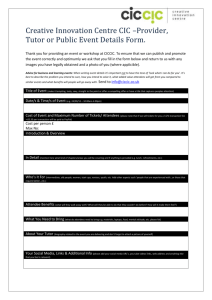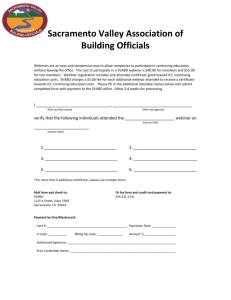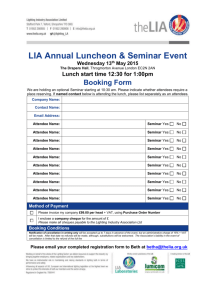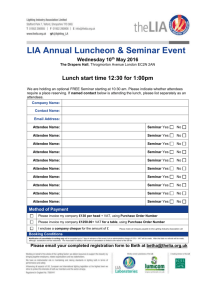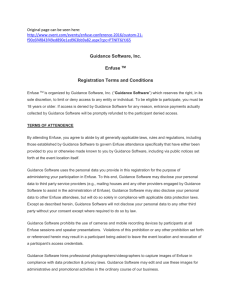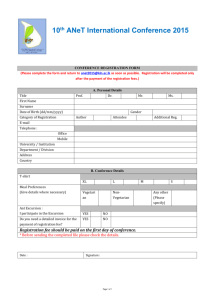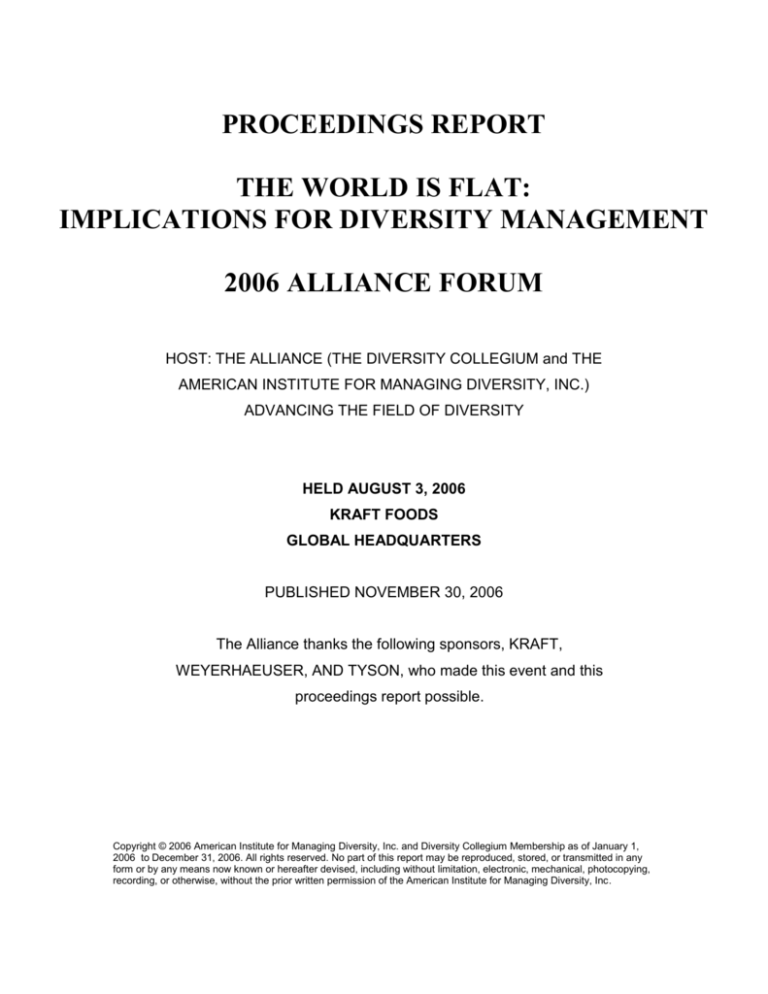
PROCEEDINGS REPORT
THE WORLD IS FLAT:
IMPLICATIONS FOR DIVERSITY MANAGEMENT
2006 ALLIANCE FORUM
HOST: THE ALLIANCE (THE DIVERSITY COLLEGIUM and THE
AMERICAN INSTITUTE FOR MANAGING DIVERSITY, INC.)
ADVANCING THE FIELD OF DIVERSITY
HELD AUGUST 3, 2006
KRAFT FOODS
GLOBAL HEADQUARTERS
PUBLISHED NOVEMBER 30, 2006
The Alliance thanks the following sponsors, KRAFT,
WEYERHAEUSER, AND TYSON, who made this event and this
proceedings report possible.
Copyright © 2006 American Institute for Managing Diversity, Inc. and Diversity Collegium Membership as of January 1,
2006 to December 31, 2006. All rights reserved. No part of this report may be reproduced, stored, or transmitted in any
form or by any means now known or hereafter devised, including without limitation, electronic, mechanical, photocopying,
recording, or otherwise, without the prior written permission of the American Institute for Managing Diversity, Inc.
Introduction
On August 3, 2006, 147 thought leaders gathered at the headquarters of Kraft
Foods in Glenview, Illinois. The task before them was to examine the
implications of Thomas L. Friedman’s seminal work The World is Flat in the
context of diversity management.
“The World is Flat” Forum was a collaborative venture of The Alliance, a strategic
relationship between the Diversity Collegium and the American Institute for
Managing Diversity. Attendees were drawn from industry, academia and
consulting, and included representatives from both the for profit and non-profit
sectors. The group’s objectives for its work were as follows:
Better understand the dynamics of the flattening world
Explore implications for diversity and diversity management on countries,
companies and individuals
Identify ways to apply the results of this dialogue
What is a “flattened world”? And, when and how did it become flat? Friedman
analogizes his discovery of the flatness of the world with Christopher Columbus’
journey to discover shorter trade routes to India. Like Columbus, Friedman’s
outcome differed from his original intent. Seeking to understand drivers of the
phenomenon of outsourcing, Friedman struck out on a globetrotting journey to
study call centers around the world, especially in Bangalore, India, and China.
What he discovered during his three-month stint of travel was more
encompassing and far-reaching than the truth behind a specific trend. As he
states, “the world went flat while I was asleep”.
Friedman defines a flattened world as “a global web enabled platform for multiple
forms of sharing knowledge and work, irrespective of time, distance, geography
and increasingly even language. If you think about that platform, you can explain
more things that are happening today.” Or can you? The flattened world is a sea
change occurring in real time. Even as organizations seek to understand its
significance, they are challenged to respond to the demands of the flattened
world in the present.
Thus the challenge before attendees was set.
As both shapers and doers in their respective organizations, what thinking
must they bring to the table to help those organizations quickly grasp and
respond to the characteristics of a flattening world at both a macro and
micro level?
What does it mean to lead a country, a company, a business unit or
division in a flattening world?
2006 Alliance Forum
2
How can leaders be educated to recognize, internalize and act in accord
with the precepts of the flattened world?
What does it mean to be a diversity competent individual in this new
landscape? How can a foundation in diversity management better
prepare us to navigate these uncharted waters?
What new mindsets, competencies, skills and habits does a flattened
world mandate?
Three members of the Alliance served as facilitators for the day. Edward H.
Hubbard, Ph. D., Kay Iwata, and Alan Richter, Ph. D. worked as a team to guide
participants through a structured process of learning, reflection and application.
A video taped presentation by Thomas Friedman formed the basis of learning.
The facilitation team organized Friedman’s findings in three groups: Globalization
and The Quiet Crisis; Flatteners, Convergence and The Great Sorting Out; and,
This is Not a Test. At the beginning of each learning segment, participants
viewed a portion of the video that explained the basic idea associated with the
segment and provided examples drawn from the real world. Attendees then
worked in small groups to discuss the implications of these learnings for their
respective diversity strategies from a threefold point of view: Marketplace
implications, both local and global; workplace implications, in terms of workplace
culture and climate; and, workforce implications with regard to representation and
workforce profile.
In the afternoon session, attendees participated in an Open Space Technology
based activity where they collectively identified what they believed to be the more
critical topics for application recommendations as outputs from the Forum.
Topics chosen were:
Global diversity
Becoming citizens of the world
Cross-cultural skills among leaders
Education, motivation and new skills for leaders
Influencing the talent pipeline
For each topic, self-selected team members worked toward developing an initial
set of recommendations that expressed why work in this area was needed,
described the future state, identified key barriers, outlined critical steps, and set
forth potential measurements of success or effectiveness.
This document of the proceedings summarizes the key inputs for each learning
event as well as comments and questions from attendees. The paper concludes
with the themes and solutions developed during the open space work sessions.
2006 Alliance Forum
3
Learning Segment 1: So What is Going On With Globalization in Your
World?
This segment introduced the fundamentals of Globalization and the Quiet Crisis
in education through a short quiz on the key concepts and a video lecture by
Friedman. Table discussion followed. Key concepts introduced included:
There are three eras of globalization that differ in terms of length of time
and drivers. During Globalization 1.0 (1492-1800) the primary driver was
countries seeking to expand their borders and influence. Globalization 2.0
(1800-2000) was driven by companies and Globalization 3.0 (2000 and
beyond) is being driven by individuals.
Globalization 1.0 and 2.0 were dominated by white Europeans and
Americans. Non-whites and non-westeners are dominating Globalization
3.0. In particular, China and India are prominent players. Along with the
former Soviet Union these countries have added more than 300,000,000
players to the global workforce.
The Quiet Crisis, a phrase attributed to Shirley Jackson, Ph. D., refers to
the dearth new American born scientists coming onto the playing field at a
time when technology and science skills are most vital. According to the
National Science Board the U. S. is now 17th in the world in terms of 18-24
year olds who receive science degrees. In engineering, universities in
Asian produce 8 times more students who receive bachelors in
engineering than the United States.
Attendees said that they were very much observing and experiencing the impact
of globalization in their companies and their world.
Attendee: I see a lot of immigration without integration. What does this mean for
our social fabric?
Attendee: Thirty percent of our business is in China. Opportunities in the urban
area are declining. Can we take the same approach to diversity and inclusion as
always?
Attendee: I think this is right on target. It’s not so much how it is going to happen
as it is it is happening right now. If everything is global, what happens if our
vendor tries to hold us hostage? We can’t function any more with any company
that is purely American. I hear a lot of “we’re not going to buy from China.” Well,
we already are.
2006 Alliance Forum
4
Attendee: We have for so long thought we were setting the grid. We’re not.
Other people don’t want to work for GE, they want to be GE.
Attendee: Cream cheese is the most global product in our company. The way
people eat changed our packaging. The flavors are different. In Mexico it’s
cream cheese with chili.
Attendee: Policy is not helping us with the need to improve education. Young
people today want instant gratification. There is a big difference between young
managers and directors and where people want to go.
Attendee: This is very applicable to what is happening today. Supply chain
rules. Nationalism has paralyzed us but we were already asleep at the wheel.
Political leaders are not in tune with the direction business is moving on this.
Attendee: America is not making our people or us globally employable. Other
countries want to lead, not follow.
Attendee: Privilege makes it hard to understand these concepts. We have
people in other countries thinking and working in 3, 4 and five languages. Yet, we
think we’re out front.
Attendee: No question the talent shortage is real. Yet, we’re making it harder to
bring talent in. Americans were brought up to think we’re the smartest. No one
is calling it a crisis but it is real.
Attendee: One thing that’s needed is just in time training. There is a new
generation of experts. With things changing so fast training has to be kept fresh.
Attendee: From a cultural perspective, we need to consider many things.
Exactly how do these drivers relate to cultural diversity around the world? We
say we prepare people for success—how does that translate in different cultures
and how does it connect to the work we do?
Attendee: Some cultures are not driven by the money trail as an example.
Cultures are shaped by values. Does that change over time? Who will adapt to
whom and why? These are questions that need to be asked?
Attendee: I’m wondering what percentage of the world has access to
technology? When we talk about China are we talking about CHINA or just a
small part of China? To what extent can a national culture adapt to this?
Discussion about globalization as a present reality was vigorous. Notably,
attendees were particularly aware of their own lens shaped by their personal life
experiences. Some acknowledged that while they had been exposed to the
effects of globalization, their worldview was “somewhat narrow”. As practitioners
2006 Alliance Forum
5
and persons interested in the development of the field, they emphasized the
need for both a broader and more hands on experience in many areas.
What, then, are the critical implications for diversity management? Attendees
posited the following:
Dialogue as a catalyst for collaboration is not a part of the political thinking
in the U.S. If change is to occur, corporations and other entities will have
to move out front in stimulating and facilitating the type of dialogue that is
needed.
There is a lack of focus on the issues, or perhaps a misdirected focus.
Leaders must find ways to bring the gravity of this subject to the forefront
in a manner that gains and sustains attention.
There is an urgent need to address the talent shortfall in the areas of
science and technology. Again, corporations and non-governmental
entities cannot afford to wait for the public sector to sort it out. Mission
critical action is needed.
Mutual reliance on talent and resources requires a new politics of
commerce. Policy cannot longer be compartmentalized along lines of
defense, public concern, etc. Outcomes of policy are too intertwined for
old models to remain effective. New paradigms are needed
Learning Segment 2: Flatteners/Convergence/The Great Sorting Out
Friedman identifies 10 factors as flatteners. More specifically, he states that the
first three formed the platform from which the remaining seven sprung. In this
segment attendees looked at the key forces that have flattened the world and
considered the tipping point in terms of the convergence of these forces.
Fall of the Berlin Wall: created a different way of looking at the world as a
flat plane. As Friedman states, “distinctions of east, west, north and south
became meaningless.”
Netscape Initial Public Offering: allowed for the first commercial browser
that in turn brought Internet accessibility and usability. More ways for
different people to connect came on stream. Most importantly, Internet
demand was the catalyst for a world wide $ 3 trillion investment in fiber
optics cable that created a literal information superhighway. “Beijing,
Bangalore and Bethesda became next door neighbors without anyone
planning it, “ Friedman states, which in turn created “more people and
more places to communicate essentially for free.
2006 Alliance Forum
6
Workflow software: New software allows work to flow seamlessly. The
net result is people are able to connect more fluidly. The new paradigm
for work, according to Friedman, “is not command and control but connect
and collaborate.”
Outsourcing: At root, outsourcing is a new form of collaboration.
Someone in Bangalore who is trained to reflect the accent and culture of
the caller now handles a telephone call to customer service.
Off shoring: Provides the ability to move factors and manufacturing
facilities easily “from Canton, Ohio to Canton, China, “ says Friedman.
Supply chaining: Technology has allowed for a global supply chain. As
an item is purchased at a local outlet in Needham, Massachusetts, and a
simultaneous trigger occurs for its replacement to be produced in another
part of the world. Supply chaining globally changes the value proposition
radically. As Friedman states, “Wal-Mart, the biggest company in the
world, makes nothing.”
In sourcing: United Parcel Service (UPS) is an example of a company
that has leveraged its core competency to become the de facto logistical
arm of many companies—yet its presence is not evident to the consumer.
Informing: With Google and other search engines, individuals can now
collaborate with data from around the world without having direct, personal
access to the data source.
The Steroids: Wireless, Voice Over Internet and file sharing serve to
turbocharge all the other forms of collaboration.
Forum attendees produced an extensive list of factors they viewed as flatteners,
independent of Friedman’s contributions. Generally, the attendee’s list fell into
one of four categories:
Communication
Mobility
Trade and Commerce
Ideological Constructs
Attendee: War in general. It used to be who you hated, now it’s who you like.
The new enemy is the old friend.
Attendee: What comes to mind for me is that it [flattening] doesn’t create equality
so much as new enemies. We are now Americans vis-à-vis the rest of the world.
2006 Alliance Forum
7
We used to have [as an example] gender issues, but now we have to band
together to get our jobs back.
Attendee: Why are we even focusing on global diversity in the flat world? Don’t
forget New York City.
Attendee: The people who will be applying for living wage jobs at Target. Those
are the flatteners. The biggest change is demographics.
Attendee: Alexander the Great brought a new leadership paradigm. Diogenes
gave us the idea of being citizens of the world.
Attendee: With regard to diversity, this means that the old rules are out. Do we
even know what diversity means in this brave new world? Who’s the majority?
Who’s the minority? What is “different” and what is “same”? In theory, diversity is
about talent and maximizing it? But are we there yet? Do we really know how to
implement when we’re still figuring out this new playing field?
What, then, are the critical implications? While attendees may not have had full
agreement as to the most significant flatteners, as one attendee said, “it’s
certainly something new!” As to the impact of flatteners on diversity
management, attendees spoke of the following:
A precise, “one-size fits all” response is not likely. New competencies that
better address the nuances of diversity are essential.
New habits, mindsets and skills are needed in a flattened world. These
broad skill sets need to be identified more concretely. Similarly ways to
develop those skills collectively and individually are needed.
Looming on the edge of critical thinking about diversity in a flattened world
is the need to be alert to the potential for renewed nationalism and
xenophobia.
Flattening has the potential to create new thresholds for exclusion. This is
especially true for organizations and entities that lack access to
technology and its related resources.
Funding for talent development at a national level is imperative. Whether
from public or private sources, the country can no longer ignore the impact
of the brain drain in the United States. Short-term thinking in this arena
will produce disastrous long-term results.
Learning Segment 3: “This Is Not a Test”
2006 Alliance Forum
8
Discussion in this segment netted out to clear agreement on the need for a wake
up call in the United States. Having considered the facts and perspectives made
by Friedman to this point, attendees quickly came to conclusions about action
that was needed. Their comments reflect both a broad view from a national
policy perspective and a specific view through the lens of thought leaders on
diversity management.
Attendee: We have to become far more collaborative. We need a national policy
toward innovation. This is a call to action.
Attendee: Stop focusing so much on blue and red and be more green. Nothing
is that simple anymore. When we demonized those labels it was really a bad
move.
Attendee: Change the way we view education. Like Japan had a national
industrial policy that helped guide it to being a superpower, we need a national
education policy.
Attendee: We always ask what new things I need to change. How about what
old things do I need to do differently?
Attendee: We’re trying to build a structure when the basement is already torn up.
We’re talking flat world when every paper you open up says let’s keep these
people out.
Attendee: I would expect educators to read this book and revise their curricula.
Attendee: It goes back to all those things we listed. It’s not only thinking outside
the box but creating a whole new box.
Attendee: Our new box is international borders and influencing them. It took
somebody from the outside to push us. It wasn’t a nudge.
Attendee: Don’t worry about policies and practices. Think about principles and
strategies.
Attendees: There are two dimensions to address—the motivation to learn and
the vehicles.
Attendees: Social structures are evolving more slowly than technological
structures. We need to understand that and find ways to incorporate the
meaning of these changes into the social structure.
Attendee: We need to trigger excitement around science and engineering.
Attendee: The new new deal is transportability.
2006 Alliance Forum
9
Attendee: This should be an opportunity based, not fear based, call for act
Attendee: Society needs to move from glorifying making enough to buy to
learning enough to create.
Key themes that emerged from this discussion were as follows:
Change the paradigms around the value of thinking and intellectual
capital. Revise curricula to reflect the new realities.
Shift from a short-term focus to long-term gratification. Invest in our
collective and individual futures. Reach out to include disenfranchised
groups.
Close the gap in the digital divide. Come from a perspective of unity.
Develop new business models based on cross-cultural competence.
Foster collaboration between companies, academia and nonprofit
organizations. Work toward a common goal.
Moving Forward
After a rich day of dialogue, debate, and discussion, attendees settled on five
areas they viewed as pivotal to moving forward in response to a flattened world
scenario. Those areas are:
Global diversity
Becoming citizens of the world
Cross-cultural skills among leaders
Education, motivation and new skills for leaders
Influencing the talent pipeline
Persons with a strong interest in one or more of these areas convened to
collaborate on specifics associated with each area.
Group 1: Global Diversity
The Need: Group members identified this as a critical area because there is a
need to have diversity management aligned with a global business model within
organizations.
2006 Alliance Forum
10
The Desired State: The future state objective would be to have a definition of
and a framework for planning and implementing for global diversity. In this state,
global thinking would be seamlessly embedded in all aspects of thinking and
doing within an organization.
The Barriers: Key barriers would include a lack of understanding and context,
diversity not recognized as a business issue in other countries (or perhaps called
something else), and general confusion about how the idea of diversity translates
around the world.
Critical Steps: To address the barriers, the team recommended a clear
definition of content and intent so that all stakeholders shared a common
understanding. Further, the team recommended a country-by-country analysis of
the implications of that definition.
Measures of Progress and Success: Ultimately, success and progress would
be measured by:
Winning in the marketplace
Stronger, more relevant recruitment and retention
Heightened morale and organizational energy
Higher profits
Positive response from the investor community
Team members focused their dialogue further to examine specific interventions
organizations might employ to build in systems that would support the creation of
the future state. Specific recommendations included:
Effective conflict management skills for leveraging diversity that would
lead to developing a truly inclusive organizational environment. Related to
this area of focus was the need for global succession planning
Creating a diversity success profile that addressed diversity of leadership
styles. Organizations would benefit by having a standardized way to
assess cultural competence. Such a profile would consciously shift
performance standards.
Creating a mindset for global success by modifying the way in which work
was done. Global teams would be the norm, with support to the teams
coming in the form of competency development.
Attendee: We don’t want a U. S. centric view of diversity. Event the subject of
diversity and it’s validity can be called into question when viewed through the
eyes of localities around the world.
2006 Alliance Forum
11
Group 2: Cross Cultural Skills for Leaders
The Need: Leaders need cross cultural skills because the demographic mix
among and within workers, customers, vendors, communities and governments
is changing. Cross-cultural skills are essential if the potential growth associated
with Globalization 3.0 is to be actualized. Stronger skills in this area support
greater access to markets and talent, model cultural competency and enable
more efficient project execution.
The Desired State: In the desired future state, cultural competence and flexibility
become part of the norm. Possible indicators would be internally based diverse
teams and true global representation on the board of multinational corporations.
The Barriers: Barriers fell into categories of internal (individual) and external.
Internal barriers include resistance, arrogance, fear of the unknown, fear of
failure, and a lack of a sense of urgency and denial. External barriers included
cost, time, and a lack of leadership.
Critical Steps: The team recommended eight key actions as the cornerstone of
a breakthrough approach.
Define competencies for leaders in terms of the business context
Raise awareness and skills through training
Showcase both successes and failures due to cultural competencies
Institute global mentoring at the leadership level
Provide incentives for skills development as part of leadership evaluation
and compensation
Develop local leaders
Begin the education process early—as early as grade school—to create
the next generation of leaders
“Globalize” all processes and policies as part of leadership responsibility
Measures of Progress and Success: Success and progress would be
measured by the change in certain key organizational indicators.
Fewer marketing and sales errors based on cultural incompetence
Goals for hiring, retention and promotion of a global leadership pool to the
highest levels in the organization (including board representation)
Market growth among diverse populations and segments
New market penetration analyzed by region and population
Baseline social audit type survey of employees and customers to create a
foundation for measuring related progress over time.
A core theme in this group’s dialogue was the need to “help leaders see” what
they may not naturally ascertain. How to motivate leaders to have a sense of
2006 Alliance Forum
12
priority around developing cross-cultural competence was a topic of much
discussion.
Attendee: The key here will be to help leaders see the need. We tend to move
when things are broken.
Attendee: There are new requirements for success. Leaders don’t see where
differences have already made them the way they are.
Attendee: We need different measurements for representation. Some way to
assess cultural differences is missing.
Attendee: Social responsibility comes into play here. Social sustainability. We
need to work on a way to audit that.
Attendee: Generational alignment is essential. There are critical steps to
address. A stakeholder analysis takes on a different meaning in a flat world.
We’re missing the tools to understand this.
Attendee: The talent picture takes on a different slant. A global company may
see consumer reasons. A local company may see something else like
employment.
Attendee: In future, human resources might be in Africa while finance is in
Ireland. This means new skills all around.
Group 3: Educating and Motivating Leaders
The Need: Group members stated that the flat world is a “sleeping giant” that
needs to be a part of the awareness of political, corporate, societal and
educational leaders. “It’s here”, they said, “and we’re already behind.”
The Desired State: The desired state would be characterized by four key
attributes: generational alignment, more collaboration, a new profile for success
and methods and means to remain viable.
The Barriers: Some of the barriers cited echoed those of the Cross Cultural
Skills Team. They include arrogance, ignorance and fear. In addition, this group
identified nationalism, policy, power dynamics and economics as potential
barriers.
Critical Steps: Group members identified eight steps as critical.
Engage leadership in discussion
Elevate the dialogue
2006 Alliance Forum
13
Develop a business case
Share facts
Provide tools
Demonstrate and share successes
Create a burning platform for different constituencies
Create and access opportunities to capture leadership attention
Measures of Success and Progress: In the bottom line, the group stated
success would be indicated when leaders respond differently. Demonstrated
competency through different decision-making would be the ultimate test.
Organizationally, higher levels of engagement around the subject would indicate
progress. Shifts in public policy at the government level, based on intelligent
public discourse, would suggest forward movement. An upward trend in
innovation, new product success and better business results based on “flat world
informed” strategies, actions and plans would be key milestones.
Group 4: Influencing the Talent Pipeline
The Need: While one group focused on this topic, there was consensus among
Forum attendees that influencing the talent pipeline formed the bedrock for all
future change. Leaders in the forum were clear that corporations and other noneducation providing entities must work with the schools at all levels to influence
the development of a stronger talent pipeline. Specific reasons cited included:
Maintaining a leadership position in the world
Responding to the domestic crisis of available talent
Helping U. S. children become better prepared to be global citizens
Enabling individuals to fulfill personal purpose and potential
Increasing the return on the dollar that companies and organizations
spend on recruiting.
The Desired State: The implied future state is the availability of a qualified
workforce, with qualification related to a number of intellectual, emotional,
technical and other skill sets.
The Barriers: Barriers to the future state included the challenge of retaining
talent, the U. S. culture of immediate gratification, societal role models that do not
edify intellectual and academic prowess and the need to understand how to
incorporate different cultural, and personal histories as well as learning styles into
approaches to education.
Critical Steps: Interestingly, this group saw the need for change at the three
levels—social, community, and individual. Their core strategies and
recommendations included:
2006 Alliance Forum
14
Encouraging families to share accomplishments
Finding ways to bridge the digital divide
Create new role models that encourage young people to value education
Make learning fun—especially around math and science
Make a second language a mandatory part of all curricula
Broker collaboration between universities, schools, museums and others
to program learning for specific groups
Broker collaboration between corporations and academia around
reviewing curricula and partnership opportunities
Involve foundations in the mix
Conclusion
The implications of Thomas Friedman’s work are clearly far reaching. Indeed,
since its publication in 2005, The World is Flat has generated dialogue about its
significance in virtually every type of endeavor. A recent Google search of the
phrase “The World is Flat Dialogue” generated tens of thousands of hits.
Only history will tell how much of what Friedman reveals is heeded—and how
well. Thought leaders in diversity, perhaps more than many others, understand
the components of how change actually occurs. Thus, attendees and their
colleagues will no doubt emerge at the forefront of taking the dialogue and
turning it into action. –END OF PROCEEDINGS REPORT-
2006 Alliance Forum
15


